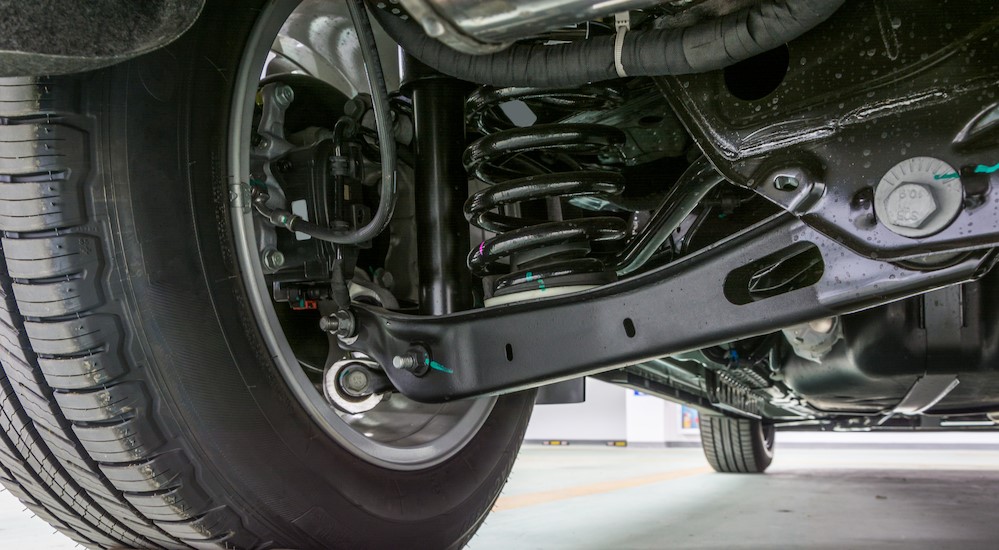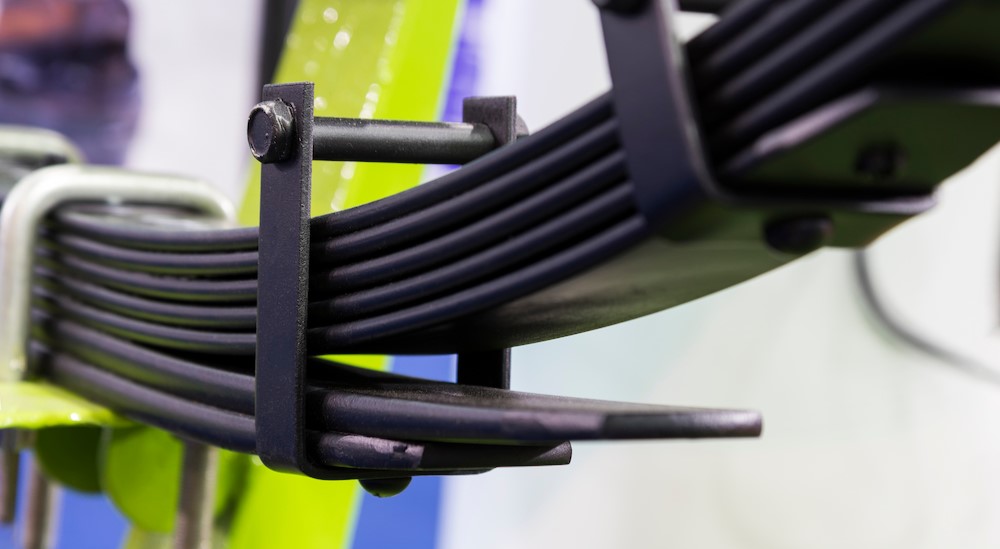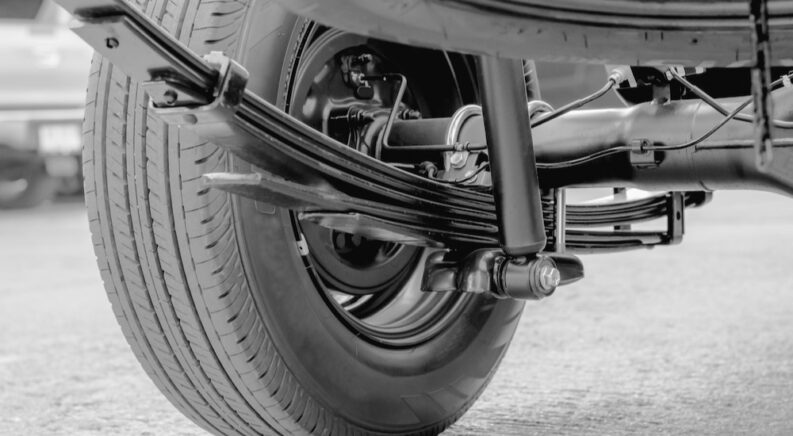The suspension is a vital part of any vehicle, but it’s especially important in larger models like SUVs and pickup trucks. A robust suspension system can allow a truck to carry heavy loads, improve stability, reduce wear and tear, and enhance comfort when you’re behind the wheel. Still, there are some key differences when it comes to the two most popular designs. Leaf springs have been around since the days of horse-drawn carriages. While they fare well in most cases, they’re often supplemented by coil springs in many newer models. Each approach has its own advantages, which is why many of today’s manufacturers use both designs, outfitting their trucks with leaf springs in the rear and coil springs in the front. What are the major pros and cons of each approach, and which type of suspension is ideal for those seeking a hard-working pickup that can tow, haul, and cruise off-road trails with the best of them? We’ll explore all that and more as we take a deep dive into coil versus leaf springs in trucks.
Leaf Springs
We’ll start with leaf springs, which have been around in one form or another since the mid-17th century. They replaced a primitive design called thoroughbraces, which were basically just leather straps. The modern leaf spring dates to around 1804 when Obadiah Elliot created a new generation of elliptical leaf springs. These were later improved thanks to advances in steel manufacturing and the development of new alloys. The springs take their name from their unique construction with multiple layers of curved, thin steel resembling a stack of leaves. When you hit a bump in the road, the curved steel starts to flatten out to absorb the impact, then regains its shape as you move onto smoother terrain. It’s a simple approach, but it’s hard to argue with a design that’s been serving drivers well for over 200 years.
Pros
The main advantage of leaf springs is their load capacity. The spring’s layered design and steel construction help to evenly distribute the weight and resist the sort of warping that could see you end up with a costly repair bill. This is partly why leaf springs are often used in heavy-duty trucks and commercial vehicles routinely towing upwards of 30,000 lbs. Affordability is another factor that contributes to the prevalence of leaf springs in modern vehicles. Brands have managed to perfect the manufacturing process over the last two centuries, but the relative lack of complexity and the affordability of steel have helped to keep costs down.
Cons
While they might be affordable and effective at dealing with oversized loads, leaf springs have a few inherent disadvantages. The simplicity of the leaf spring design means they tend to be more rigid than their coil spring counterparts. This rigidity can lead to a less comfortable ride, particularly when a truck isn’t carrying much cargo. This could be a dealbreaker if you’re the type of driver who prioritizes comfort above all else, but most pickup owners are happy to trade a rougher ride for the sort of utility that leaf springs can offer. If there’s one area where leaf springs are lacking compared to coil springs, it’s articulation. This term describes how well the suspension can bend or flex when traversing bumpy, uneven terrain. This flexibility is important when keeping all four wheels on the ground in off-road scenarios, and leaf springs tend to come up a little short. While they can deliver some moderate off-road performance, coil springs have become the go-to for those who like to explore well off the beaten path.

Coil Springs
Coil springs might be newer than leaf springs, but they’re not exactly what you’d call a modern invention. Coil springs first started appearing on production vehicles in 1906 when the Brush Motor Company first introduced the Runabout. While the two-passenger car would enjoy a relatively short production run, it would set the stage for years of automotive development due to its novel coil spring suspension. While initially unheralded, the design would gain steam a few decades later as most major auto brands started to work coil springs into their vehicles’ front suspension. Steel absorbers and lower-pressure tires further enhanced comfort, which also became popular around the same time. Buick was a leader in this new technology, employing coil springs for many of its smaller models.
Pros
Those looking for a truck that excels in comfort and control should seek a model with coil springs for a few simple reasons. Leaf springs are pretty effective at absorbing shocks, but they’re no match for coil springs in terms of overall ride quality. Coils compress under pressure thanks to their spring-like design, soaking up bumps and reducing vibrations throughout the vehicle. This is why coil springs are often used in passenger cars, SUVs, and many light-duty trucks, where comfort, not towing capacity, is often the prime selling point. The design also pairs well with the off-road lifestyle, with improved articulation providing a more enjoyable and effective journey. Coil springs offer a wider range of motion and create less interference when stressed to the max, unlike in leaf springs, where full articulation can cause the suspension to bind and produce excess friction. Off-road vehicles with coil springs are better at keeping all four wheels on the ground, which can make a big difference when navigating boulders, rocks, and deep pits. Coil springs can also lead to lower maintenance and repair costs over a vehicle’s service life since they’re much easier to maintain thanks to the lack of regular lubrication.
Cons
The disadvantages of coil springs largely come down to load capacity and cost. If you’re an industrious trade pro, farmer, or contractor who regularly nears your truck’s maximum towing and payload capacity, coil springs might not be for you. The same qualities that allow coil springs to improve comfort detract from their ability to handle heavy loads. Leaf springs compress and become progressively stiffer as they’re weighed down, while coil springs tend to experience some troubling flexibility when pushed to their limit. Leaf springs also distribute weight over a larger area than coil springs, spreading the force and putting less of a toll on the suspension. Finally, there’s the cost. Coils require brands to develop more complex manufacturing processes to wind the springs into shape. They’re also typically made from chrome-silicon alloys or high-carbon steel, while leaf springs tend to employ more affordable 5160 spring steel. There’s also a key difference in how they’re affixed to the vehicle, with coil springs requiring a system of links to bind to the axle. All these factors add to the bottom line and make coil springs a little pricier on average.

Which Is Better?
There’s no clear winner in the debate between leaf and coil springs. Each design serves a specific purpose, allowing drivers to prioritize load capacity, cost, comfort, and off-road ability as they see fit. It all comes down to a truck’s intended use. Are you looking for a heavy-duty pickup that can take advantage of every pound of towing and payload capacity? Leaf springs are the obvious choice. Are you hunting for a smooth daily driver that can handle a little off-road action? Coil springs are the way to go. Ultimately, the decision isn’t up to the driver, as most contemporary pickups are designed with front coil springs and rear leaf springs, though there are some notable exceptions. The Ram 1500 and Toyota Tundra TRD Pro both offer rear coil springs in an attempt to up their off-road profile, while heavy-duty trucks still rely on rear leaf springs to enhance towing ability. Drivers can always swap out their coil or leaf springs for a new set, but it can be an expensive, labor-intensive process. Regardless of your approach, today’s leaf and coil springs represent a marked advantage over early designs, allowing today’s pickup to tackle new terrain and handle even the toughest towing tasks.

